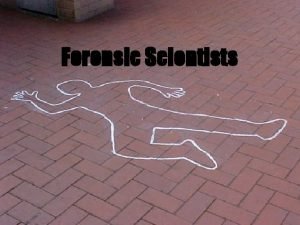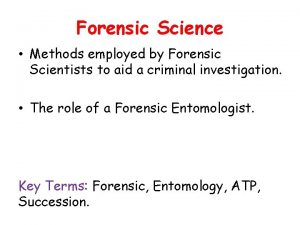Organics Organic Structures Many materials that forensic scientists













- Slides: 13

Organics

Organic Structures • Many materials that forensic scientists collect at a crime scene are organic in nature. • Carbon atoms make the backbone of all organic structures. • This is because carbon is able to make four stable bonds which provides a lot of variety in bonding possibilities. • The carbon chains can change their behavior depending on the type of bond as well. • How they are shaped determines not only how they interact with the body or environment, but also in the method of detection and identification.

Carbon – Carbon bonds • Carbon can make single bonds (a sharing of one pair of electrons) with other carbons or other elements. • Carbon can also make double bonds (a sharing of two pairs of electrons) or triple bonds (3 pairs of electrons)

More Carbon – Carbon bonds • Carbon chains can also make a ring structure or single bonds. • The ring can also contain double bonds. • Alternating single and double bonded rings are called aromatics. Benzene or a phenyl group

Branches • Off of the main chains or rings can be carbon branches. • In addition, rings may connect and link up.

Functional groups • When oxygen, nitrogen, phosphorous, and sulfur get involved they change the function of the whole molecule. • There are many functional groups. • Ones containing the an OH bonded to the carbon chain are called alcohols. (cholesterol? )

Carbonyl group • The carbonyl group is when a carbon is double bonded to and oxygen. • These are called aldehydes or ketones if the carbonyl group is not attached to other oxygen, nitrogen, or other functional atoms.

Organic Acids and Esters • Carboxylic acids have a carbonyl group and an alcohol group off of the same carbon. • Esters have a carbonyl group and an oxygen linking to a second chain off of the same carbon.

Ethers and Epoxys • Ethers have an oxygen linking two carbon chains. • Epoxys have an oxygen that is attached to two carbons on the same chain.

Amines and Amides • Amines have a nitrogen single bonded to a carbon. • Amides have a nitrogen single bonded an oxygen double bonded to the same carbon.

Nitriles and Nitro groups • Nitriles have a triple bond between the nitrogen and carbon. • Nitro groups are nitrogens with two oxygens.

Name the functional groups Phenethylamine Synthetic Cannabinoid

Name the functional groups Oxycodone
 Midwest organics recycling
Midwest organics recycling Why are observation skills important in forensics?
Why are observation skills important in forensics? Pathologist and anthropologist
Pathologist and anthropologist Forensic psychiatry vs forensic psychology
Forensic psychiatry vs forensic psychology Phân độ lown
Phân độ lown Block nhĩ thất độ 2 type 1
Block nhĩ thất độ 2 type 1 Thể thơ truyền thống
Thể thơ truyền thống Thơ thất ngôn tứ tuyệt đường luật
Thơ thất ngôn tứ tuyệt đường luật Chiến lược kinh doanh quốc tế của walmart
Chiến lược kinh doanh quốc tế của walmart Tìm độ lớn thật của tam giác abc
Tìm độ lớn thật của tam giác abc Con hãy đưa tay khi thấy người vấp ngã
Con hãy đưa tay khi thấy người vấp ngã Tôn thất thuyết là ai
Tôn thất thuyết là ai Gây tê cơ vuông thắt lưng
Gây tê cơ vuông thắt lưng Sau thất bại ở hồ điển triệt
Sau thất bại ở hồ điển triệt
























